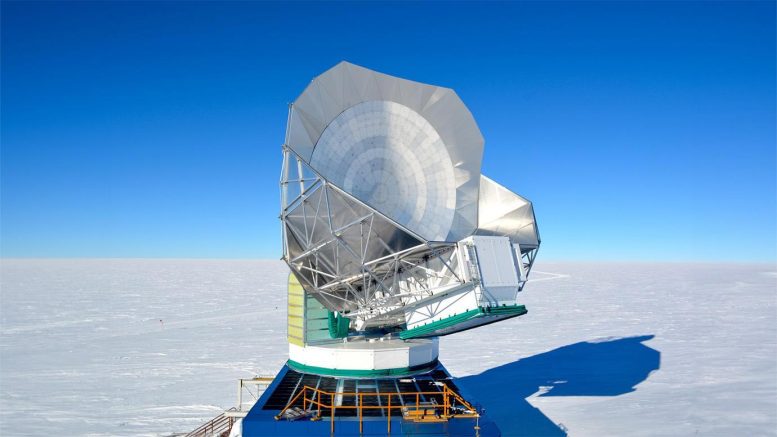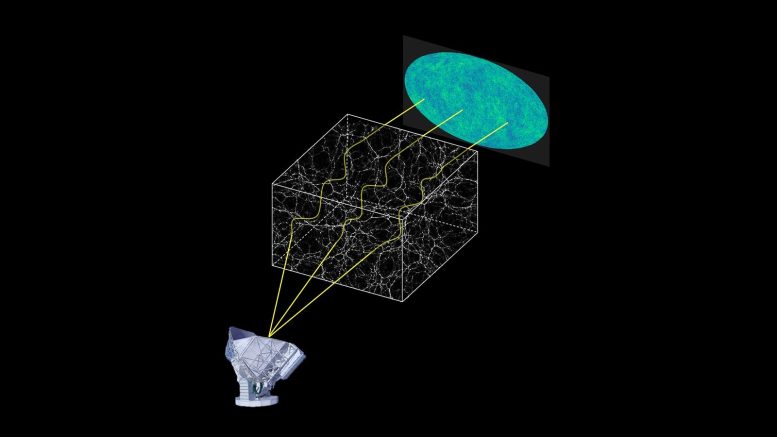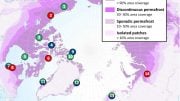
The South Pole Telescope’s camera received an upgrade in 2017. An analysis of initial observation data was just published in the journal Physical Review D. Credit: Brad Benson/University of Chicago.
Gravitational lensing maps from initial data promise even more detail.
Argonne is part of a multi-institutional effort to survey the sky for clues about the origins and nature of our universe.
For more than five years, scientists at the South Pole Telescope in Antarctica have been observing the sky with an upgraded camera. The extended gaze toward the cosmos is picking up remnant light from the universe’s early formation. Now researchers have analyzed an initial batch of data, publishing details in the journal Physical Review D. The results from this limited dataset hint at even more powerful future insights about the nature of our universe.
Breakthroughs in Cosmic Microwave Background Analysis
Located at the National Science Foundation’s Amundsen-Scott South Pole Station, the telescope received a new camera in 2017 known as SPT-3G, which was constructed and now operated by a collaboration led by the University of Chicago.
Equipped with 16,000 detectors — 10 times more than its predecessor — the SPT-3G is central to multi-institutional research led in part by Argonne National Laboratory. The goal is to measure faint light known as the cosmic microwave background. The cosmic microwave background is the afterglow of the Big Bang, when the universe burst forth from a single point of energy nearly 14 billion years ago.

The cosmic microwave background — the universe’s oldest light — has traversed vast distances before reaching us. During its extended journey, gravitational forces from massive cosmic structures caused its trajectory to bend before being captured by the South Pole Telescope. Credit: Zhaodi Pan/Argonne National Laboratory
“The CMB is a treasure map for cosmologists,” said Zhaodi Pan, the paper’s lead author and a Maria Goeppert Mayer fellow at Argonne. “Its minuscule variations in temperature and polarization provide a unique window into the universe’s infancy.
Gravitational Lensing and Dark Matter Insights
The paper in Physical Review D offers the first CMB gravitational lensing measurements from the SPT-3G. Gravitational lensing happens when the universe’s vast web of matter distorts the CMB as it travels across space. If you were to place the curved base of a wine glass on the page of a book, the glass would warp your view of the words behind it. Similarly, matter in the telescope’s line of sight forms a lens that bends the CMB light and our view of it. Albert Einstein described this warping in the fabric of space-time in his theory of general relativity.
“The CMB is a treasure map for cosmologists. Its minuscule variations in temperature and polarization provide a unique window into the universe’s infancy.” — Zhaodi Pan, Maria Goeppert Mayer fellow at Argonne
Measurements of that distortion hold clues about the early universe and mysteries like dark matter, an invisible component of the cosmos. “Dark matter is tricky to detect, because it doesn’t interact with light or other forms of electromagnetic radiation. Currently, we can only observe it through gravitational interactions,” Pan said.
Scientists have been studying the CMB ever since it was discovered in the 1960s, observing it through telescopes both on the ground and in space. Even though the newest analysis uses only a few months of SPT-3G data from 2018, the measurement of gravitational lensing is already competitive in the field.
“One of the really exciting parts of this study is that the result comes from what’s essentially commissioning data from when we were just beginning observations with the SPT-3G — and the result is already great,” said Amy Bender, a physicist at Argonne and paper co-author. “We’ve got five more years of data that we’re working on analyzing now, so this just hints at what’s to come.”
Promising Future Research Directions
The dry, stable atmosphere and remote location of the South Pole Telescope create as little interference as possible when hunting for CMB patterns. Still, data from the highly sensitive SPT-3G camera contains contamination from the atmosphere, as well as from our own galaxy and extragalactic sources. Analyzing even a few months of data from SPT-3G is an undertaking that lasts years, since researchers need to validate data, filter out noise and interpret measurements. The team used a dedicated cluster, a group of computers, at the Argonne Laboratory Computing Resource Center to run some of the calculations for the research.
“We found that the observed lensing patterns in this study are well explained by general relativity,” Pan said. “This suggests that our current understanding of gravity holds true for these large scales. The results also strengthen our existing understanding of how structures of matter formed in our universe.”
SPT-3G lensing maps from additional years of data will also help in probing cosmic inflation, or the idea that the early universe underwent a fast exponential expansion. Cosmic inflation is “another cornerstone of cosmology,” Pan noted, and scientists are hunting for signs of early gravitational waves and other direct evidence of this theory. The presence of gravitational lensing introduces interference with inflationary imprints, necessitating the removal of such contamination, which can be calculated using precise lensing measurements.
While some results from the new SPT-3G data will reinforce existing knowledge, others will raise new questions.
“Every time we add more data, we find more things that we don’t understand,” Bender said who holds a joint appointment at the University of Chicago. “As you peel back layers of this onion, you learn more and more about your instrument and also about your scientific measurement of the sky.”
So little is known about the universe’s unseen components that any understanding gained is critical, Pan said: “The more we learn about the distribution of dark matter, the closer we get to understanding its nature and its role in forming the universe that we live in today.”
Reference: “Measurement of gravitational lensing of the cosmic microwave background using SPT-3G 2018 data” by 12 December 2023, Physical Review D.
DOI: 10.1103/PhysRevD.108.122005
This work was funded by the National Science Foundation’s Office of Polar Programs and the DOE Office of Science’s High Energy Physics program. The scientific analysis was led by Pan, in close collaboration with lead co-authors W. L. Kimmy Wu and Federico Bianchini (SLAC National Lab) and the SPT-3G collaboration. Argonne-affiliated co-authors with Bender and Pan are Lindsey Bleem, Karen Byrum, John Carlstrom, Faustin Carter (Argonne alumnus), Thomas Cecil, Clarence Chang, Junjia Ding (Argonne alumnus), Riccardo Gualtieri (Argonne alumnus), Angelina Harke-Hosemann (Argonne alumnus), Jason Henning (Argonne alumnus), Florian Kéruzoré, Trupti Khaire (Argonne alumnus), Steve Kuhlmann, Valentine Novosad, John Pearson, Chrystian Posada (Argonne alumnus), Gensheng Wang and Volodymyr Yefremenko.









The article does not tell anything new about dark matter.
Dark matter is only a hypothesis. There has never been any conclusive evidence to prove it exists.
Ideal fluids are everywhere, just like the so-called neutrinos or dark matter, but they cannot be detected. There is no eternal steady-state mass, but eternal fluid mechanics and perpetually swirling topological vortices.
Science must follow mathematical rules. For example, the Standard Model (SM) is considered to be one of the most significant achievements of physics in the 20th century. However, the magnetic moment of μ particle is larger than expected, revealed by a g-2 experiment at Fermilab, suggests that the established theory (such as SM) of fundamental particles is incomplete. Furthermore, the SM omitting gravity, it not involved the time problem and when the particle movement starts. Mathematics is the foundation of science. Physics must respect the scientific nature of mathematics and mathematical models. The SM must be based on mathematical models in order to be scientific, convincing, and in line with natural laws.
I hope researchers are not fooled by the pseudoscientific theories of the Physical Review Letters (PRL), and hope more people dare to stand up and fight against rampant pseudoscience.
The so-called academic journals (such as Physical Review Letters, Nature, Science, etc.) firmly believe that two high-dimensional spacetime objects (such as two sets of cobalt-60) rotating in opposite directions can be transformed into two objects that mirror each other, is a typical case of pseudoscience rampant.
If researchers are really interested in Science and Physics, you can browse https://zhuanlan.zhihu.com/p/643404671 and https://zhuanlan.zhihu.com/p/595280873.
LCDM fanatics remain scientifically “festive,” having realized how depressing Einstein’s stuff can be for people who aren’t really that much in to pretending to save the world from Nazis by declaring space and time must bend during gravitational lensing, so that light majestically doesn’t have to.
Take a laxative.
Dark matter can be tricky to detect? It may be impossible to detect it at all if it doesn’t exist in the first place. Inferring it’s existence due to gravitational effects will only work if our current theory of gravity is correct and lately there have been alot of thought that it may not be.
Misleading clickbait title.
Need to try harder SciTechDaily